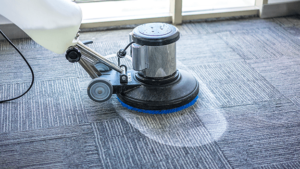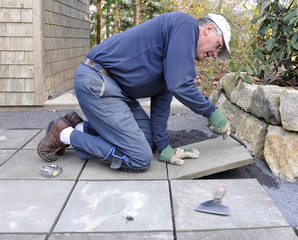Carpet Cleaning El Dorado Hills is a necessary maintenance routine that prolongs your carpet’s life and helps maintain indoor air quality. Vacuuming frequently and treating spills promptly is the most important preventative measure, followed by frequent hot-water extraction for deeper soil removal.
Vacuuming should be done at least a few times per week and more often in high-traffic areas. Also, consider placing doormats outside every entrance to trap dirt and dust particles before they can enter your home.

Vacuuming is one of the most important steps in keeping your carpets clean. It not only helps to lift dirt, pet hair, and dander that makes your carpets look dingy but also can contribute to a musty odor in the home. Regularly vacuuming helps prevent this buildup and is a key component of maintaining your investment in carpets, area rugs, stairs and flooring.
A good vacuum cleaner will have a rotating brush to help loosen and remove the deep-encrusted soil in your carpet. This is particularly important for homes with longer carpet styles, such as frieze and wool. Avoid using the beater bar on these styles, as it may damage them.
Regular vacuuming and addressing spills promptly are crucial for extending the life of your carpets. However, these steps only go so far. Over time your carpets will still harbor a wide variety of environmental soils and stains that require deeper cleaning. These soils break down carpet fibers and can cause a variety of problems including matting, foul odors and premature wear.
The most common methods for deep carpet cleaning are very low moisture (VLM) and hot water extraction (HWE). VLM uses a portable machine that forces both cleaning solution and water into the carpet’s fibers, which is then extracted, along with the soils, during the cleaning process. This method works well and has a quick drying time within 2 hours.
HWE is a more labor-intensive process and relies on a truck-mounted system to spray cleaning solution into the carpet, followed by hot water being extracted from the soil. HWE is very effective and has a faster drying time, often within 1 hour. HWE depends on the participation of homeowners for a successful and complete cleaning, and most Service Providers expect homeowners to vacuum before they arrive.
When you do decide to vacuum, it is recommended that you use the slowest speed possible and overlap each pass, in order to effectively pull up encapsulated soils. It is also a good idea to have a range of hose attachments that can be used for difficult areas and to reach under furniture and other items. Be sure to check the specific instructions from your carpet cleaning Service Provider, as they will offer guidance on vacuuming techniques and frequency based on the method of cleaning you’ve chosen.
Baking Soda
Baking soda is nature’s deodorizer, and it can do a wonderful job of eliminating odors from carpet fibers. However, it does not actually clean the carpet; it simply absorbs odors from the surface and then clings to the carpet fibers and backing as well as any remaining dirt particles and moisture that are left behind. This is why it is very important that you be careful with how you use baking soda in your home.
The best way to utilize baking soda in a cleaning routine is to sprinkle it on the floor and let it sit for at least an hour (overnight is even better). Then, using a brush or vacuum cleaner, gently scrub the area and then blot it until it is dry. If there are any lingering odors or residue, repeat the process as needed.
Another great use for baking soda is to treat greasy and non-greasy stains in the home. You can find a lot of different ways to treat these stains, but they are all based on the same concept. First, make sure that you are using white vinegar, as other types of vinegar can leave a discolored stain on the carpet. You will then need to cover the greasy or non-greasy stain completely with baking soda, making sure to use an abundant amount to ensure complete coverage. Next, you will need to wait – this is very important – until you notice fizzing or bubbling of the baking soda. This indicates that the chemical reaction between the baking soda and the vinegar is taking place and that you are getting closer to removing the stain.
When used in this manner, baking soda will usually remove greasy and non-greasy stains from the majority of carpet fibers. This is because of the powerful chemical reaction that takes place between the vinegar and the baking soda. The only problem is that if the stain is very deep or if there are very dark stains, these types of stains may still be visible.
For these more severe stains, you will want to try something slightly different. You will need to use a more aggressive mixture of vinegar and water, and this will typically require some scrubbing. It is also a good idea to use a dehumidifier in the room where the stain occurred to help draw out any remaining moisture and discourage mold spores from settling in.
Hot Water Extraction
Hot water extraction is one of the more popular carpet cleaning methods that professional carpet cleaners utilize. This method involves using industrial equipment that shoots hot water (sometimes along with a cleaning solution) into the stained areas of your carpet and then promptly extracts it with powerful vacuum action. This method not only cleans and removes stains but it also goes deep into your carpet fibres to flush out dirt and grime that has settled there over time. This is important because sanitising your carpet will only do so much; it will not actually clean the impurities that are trapped within the fabric.
The cleaning solution that is used in this process will be mixed with hot water to loosen any stuck-on dirt and debris. Once the cleaning solution has had a chance to work its magic on the surface of your carpet, the powerful vacuum of the machine will whisk it all away to be stored in a tank in the back of the truck. This leaves your carpet free of dirt and debris, and incredibly fresh and clean.
When compared to steam cleaning, this is a far more thorough and effective cleaning method. This is because steam cleaning only sanitises the surface of your carpet and will not remove any dirt that has settled in the deeper layers.
Another reason to use this method is that it can get rid of a lot of the allergens that are found in your carpet. This includes pet dander, dust mites and a variety of other nasty things that can irritate asthma and exacerbate respiratory problems. In addition, it can also help to eliminate a wide range of other contaminants that are commonly found in homes such as cigarette smoke and fungi.
A word of warning, though; this is not a job that can be done by the average homeowner and it should be left to the professionals. Those who try to use this technique with their own machines typically leave your carpet wet, which can damage your floors and even lead to the growth of mould. Those who hire unqualified individuals based on price alone often find that their amateur efforts only serve to make the problem worse, as they use cheap machines that are not powerful enough to do the job properly.
Preventative Maintenance
Carpet is often a desirable feature in homes and businesses because it adds warmth, softness, and an aesthetic appeal. It can also provide acoustic properties and help to absorb noise and vibrations. However, like any other surface, carpet can collect and trap dirt and dust which will affect the appearance and lifespan. Proper care and maintenance can help extend the life of your carpet and prevent premature wear, stains, and discolouration.
Regular vacuuming is a must to remove surface dirt and debris from your carpets. Try to vacuum at least once a week, paying special attention to high traffic areas and under furniture. It is also important to use a quality vacuum cleaner that is appropriate for your carpet type. A vacuum cleaner with HEPA filters is recommended for removing allergens from your carpets.
A thorough and consistent cleaning schedule is key to extending the life of your carpet. Ideally, you should have your carpet professionally cleaned on a scheduled basis. This will ensure that your carpet is thoroughly cleaned and free of any hidden dirt or stains.
If you have a high traffic area, consider having it treated with stain repellent prior to cleaning to reduce the risk of re-staining. You can also apply a fabric protectant to your carpets to help them resist stains and spills. This will help them stay looking fresher for longer.
Stains and spills should be blotted as soon as possible to avoid permanent damage. Use an absorbent white cloth or paper towel (do not use one with prints or colours as this can bleed into the carpet) to blot the stain. A small amount of water mixed with a mild detergent may be used for water soluble stains. If a stain persists, a commercial degreaser should be used in consultation with your local carpet professional.
Regular maintenance will not only keep your carpets clean and fresh but it will also help to extend their lifespan and reduce the cost of replacement. A preventative carpet maintenance program can be implemented with the right training, carpet care products and equipment.
